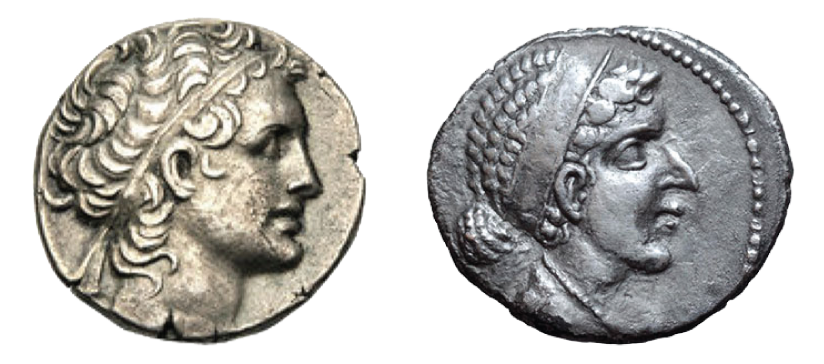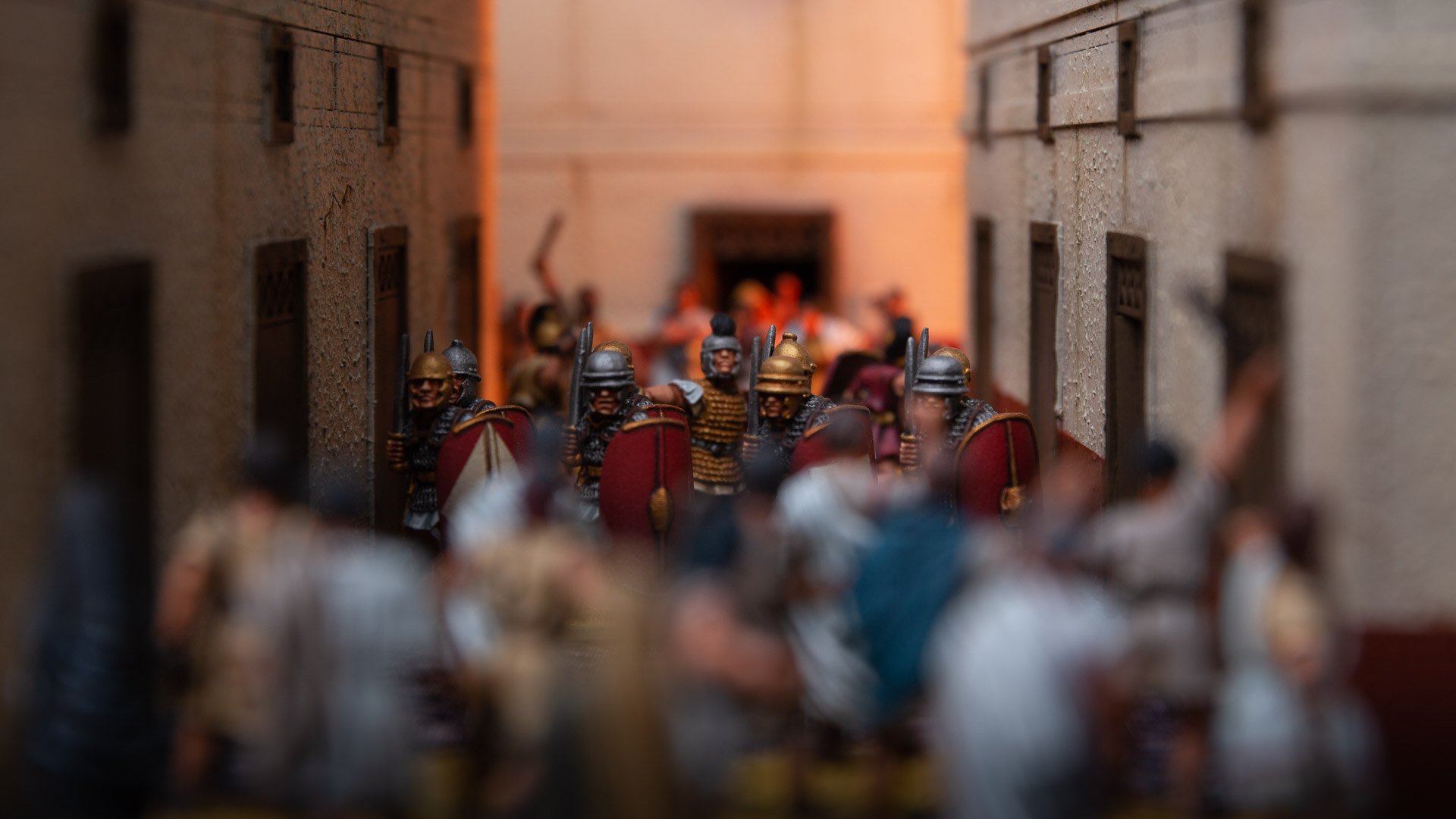Siege of Alexandria - Stalingrad on the Nile
Brutal street fighting, naval landings, treachery, betrayal - and a love affair. The Siege of Alexandria isn’t Caesar’s most famous battle but it was exciting, diverse and probably one of his hardest fights.
A Roman testudo makes its way down a street in Alexandria. An enemy javelin has felled one of the legionnaires, opening up a dangerous gap in the formation.
The Alexandrian War - as Caesar referred to his stay in Egypt - contains much more drama than his supposed love affair with Cleopatra. Caesar had just defeated his rival Pompey the Great at the battle of Pharsalus and was close to claiming victory in the civil war. But Pompey managed to escape, setting sail for Egypt where he hoped he would be able to cash in on old favours with the Ptolemies. Caesar chased after him.
I started painting romans as a pandemic project three years ago. At the time I was reading Adrian Goldsworthy’s “Caesar” and while there are a lot of interesting episodes in Caesar’s life I was fascinated by his stay in Egypt. The whole episode is often overshadowed by the relationship between Caesar and Cleopatra but there is so much more going on. The old and decadent Ptolemaic dynasty, the armies facing each other, the fighting in the harbour and the city, the intriguing characters and not least the city of Alexandria itself.
Two civil wars
At the time Egypt was involved in a civil war between the young pharaoh Ptolemy XIII Theos Philopator and Cleopatra VII, his wife and sister. Ptolemy XIII, only 14 years old, had a number of advisors, the eunuch Pothinus, the commander in chief Achillas and the young pharaohs teacher Theodotus of Chios, who acted as regents for him. Together they conspired to have Cleopatra deposed - her popularity among the people intimidating them - thus leaving Ptolemy as the lone ruler. Cleopatra fled to Syria where she raised an army and started to plan her return to the throne.
Tetradrachms of Ptolemy XIII and Cleopatra VII. Note that Cleopatra’s coin was minted six or seven years after the siege of Alexandria. Source: CoinWeek Ancient Coin Series: The Ptolemies, Part III.
In late September 48 BC Pompeys ships reached Egypt. At first Ptolemy pretended to act as his friend, accepting his plea for help. But the young king must have known that Pompey was a beaten man and that Caesar was the new strong man in Rome. Ptolemy had Pompey murdered by his general Achillas and the commander of the Gabiniani, a Roman named Lucius Septimius.
A few days later Caesar arrived with his forces in Alexandria and was presented with Pompeys signet ring and severed head. His reaction was not what Ptolemy had expected;
“Theodotus presented to him the head and ring of Pompeius, he was grievously offended, and wept over them.”
The relations between Ptolemy and Caesar were not off to a good start and they were soon made worse. Not only did Caesar demand the money that Ptolemy's father, Ptolemy XII Auletes, had borrowed from Rome to regain his throne seven years ago but he also decided to settle the dispute between Ptolemy and his sister.
Our sources differ on how Caesar and Cleopatra actually met for the first time. Plutarch tells us she was smuggled inside a sack past her brother's guards in the palace and presented to Caesar. We don’t know if this is true but it certainly adds to the Hollywood-mythos of the pair. However they met and whoever seduced who, their alliance would seal Caesar's fate in Egypt as he sided with Cleopatra in the dynastic conflict.
Caesar demanded that the siblings disband their armies and make peace, war in Egypt would threaten the vital grain supply to Rome. Pothinus, one of the young king's advisors, was not prepared to do this and instead sent Achillas, another advisor, to the army with orders to march on Alexandria. All of a sudden Caesar was basically trapped inside the royal quarters with his army and the Ptolemaic court. The people of Alexandria quickly angered when they heard that the Romans, in Pothinus' words, had taken their young king as a captive in the palace and riots broke out in the streets.
A map of Alexandria as it would have looked around the time of the siege in 48 BC. It is based on the maps by Judith McKenzie in her “The architecture of Alexandria and Egypt” with some assistance by Michael Bengtsson’s reconstruction of the palace area in Alexandria.
Caesar besieged
The siege turned out to be a lengthy affair where the Romans were mostly trapped in the royal quarters and harbour of Alexandria. Barricades and high thick walls were erected in the streets and fighting raged from house to house and over rooftops. Holes were made through buildings to ease the movement of troops and supplies. Caesar mentions in his commentaries that the Egyptians built great siege towers on wheels that could be moved around the city to where they were needed. The Romans on the other hand built battering rams to knock down walls and houses and according to Cassius Dio a moat and wall around the palace
There were also naval engagements both in Alexandria’s harbours and outside on open water. The capture of Pharos Island enabled the Romans to be supplied by sea. Supplies must have been a constant problem for both sides but unfortunately the logistics of the campaign are often left out of the sources. At one time though the Alexandrians manage to flood the water supply of the Romans with sea water, putting Caesar and his men in a precarious situation. Fortunately for the Romans they started digging wells and soon found fresh water. Civilians must also have played a central role in the battle. Civilians in the Roman-controlled parts of the city were never evacuated and supplies would have been needed for them as well. I can’t imagine Cleopatra accepting her court and subjects being starved right in front of her, that probably wouldn’t have helped her cause in the struggle for the throne.
The Romans were greatly outnumbered, Caesar had only brought two understrength legions, about 3200 men, and 800 cavalry, with him to Alexandria. They faced the entire might of the Ptolemaic royal army, 20 000 infantry and 2000 cavalry. I’ll discuss the armies involved in more detail in further parts of this series. Suffice to say at the moment the Romans were outnumbered even though fresh troops continued to reinforce Caesar throughout the siege. The Ptolemaic army was also steadily reinforced as Achillas had called for a levy to be assembled and all the adult slaves of Alexandria were armed and used as soldiers, mostly for guard duty. The effectiveness of these troops can obviously be discussed.
The battle inside Alexandria raged for months without any side gaining the upper hand. The Romans managed to eliminate the Egyptian fleet and gain control of Pharos island. But they did not manage to seize the Heptastadion, the 180 metre long causeway that connects Pharos to Alexandria, nor did they manage to oust the Ptolemaic forces from the city.
A roman patrol is attacked by a mob in an alleyway. Even before the siege started properly alley’s and backstreet’s in Alexandria was a dangerous place for the legionnaires.
One of the best allies of the Romans in Egypt turned out to be the intrigues of the Ptolemaic court. At the start of the conflict Cleopatra's younger sister Arsinoë had fled Caesar’s captivity and joined Achillas and the army. It wasn’t long until she had lost faith in Achillas and had her guardian, the eunuch Ganymedes, kill him and she then proclaimed herself queen. Ganymedes was put in command of the army and seems to have been a competent commander but fared little better than Achillas. Soon enough the other Egyptian generals grew tired of both Ganymedes and their new queen and contacted Caesar asking for their king back in exchange for peace. Caesar doesn't seem to have been entirely sure of their honesty but released Ptolemy XIII to his own people. His scepticism, or naivety, was proven right because as soon as the king returned to his own people the attacks by the Alexandrians started again, more intense than ever before.
Relief from the east
At the outbreak of hostilities in Alexandria a man named Mithridates of Pergamon had been sent to Anatolia and Syria to gather forces and come to Caesar’s aid. I will cover this relief column more in depth in a later instalment of this series. He had managed to gather an impressive force and marched down the coast of the Levant and in March 47 BC he reached Pelusium, the town guarding Egypt’s eastern flank. He immediately stormed the city, took it and marched south with his forces into the Delta to try and cross the Nile. When news reached Ptolemy XIII he immediately sent a strong force to stop Mithridates. This force was also beaten by Mithridates so the young king decided to take what was left of the royal army and leave Alexandria in a last bid to beat Mithridates and stop him from joining forces with Caesar. Soon after Caesar too left Alexandria to try and combine his forces with Mithridates.
Caesar’s struggle for Egypt continued for a short while as he chased the young king Ptolemy XIII down the Nile. But the siege of Alexandria was over. For six months the Romans and Ptolemies had been locked in a struggle in the biggest city in the world with a population of hundreds of thousands. And suddenly it just ended. We don’t know how many soldiers were killed or wounded during this time. Much less how many of the civilian population died of starvation or disease or had to flee their homes. Large parts of the city were destroyed, among the buildings damaged was the famous Great Library.
This project has kept me busy for three years and I still find this comparably small conflict very interesting and I hope you will too. I have plenty more articles about Alexandria, the armies and the conflict planned for the coming months.





The Ptolemaic army was only a shadow of its former self in 47 BC but still proved to be a match for Caesars legions in Alexandria.